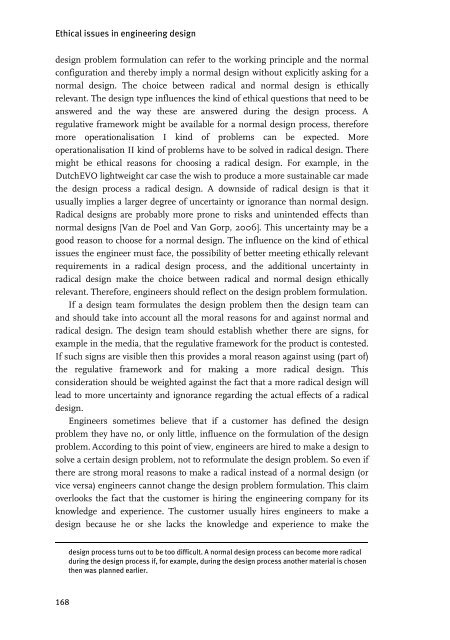Ethical issues in engineering design - 3TU.Centre for Ethics and ...
Ethical issues in engineering design - 3TU.Centre for Ethics and ...
Ethical issues in engineering design - 3TU.Centre for Ethics and ...
You also want an ePaper? Increase the reach of your titles
YUMPU automatically turns print PDFs into web optimized ePapers that Google loves.
<strong>Ethical</strong> <strong>issues</strong> <strong>in</strong> eng<strong>in</strong>eer<strong>in</strong>g <strong>design</strong><br />
<strong>design</strong> problem <strong>for</strong>mulation can refer to the work<strong>in</strong>g pr<strong>in</strong>ciple <strong>and</strong> the normal<br />
configuration <strong>and</strong> thereby imply a normal <strong>design</strong> without explicitly ask<strong>in</strong>g <strong>for</strong> a<br />
normal <strong>design</strong>. The choice between radical <strong>and</strong> normal <strong>design</strong> is ethically<br />
relevant. The <strong>design</strong> type <strong>in</strong>fluences the k<strong>in</strong>d of ethical questions that need to be<br />
answered <strong>and</strong> the way these are answered dur<strong>in</strong>g the <strong>design</strong> process. A<br />
regulative framework might be available <strong>for</strong> a normal <strong>design</strong> process, there<strong>for</strong>e<br />
more operationalisation I k<strong>in</strong>d of problems can be expected. More<br />
operationalisation II k<strong>in</strong>d of problems have to be solved <strong>in</strong> radical <strong>design</strong>. There<br />
might be ethical reasons <strong>for</strong> choos<strong>in</strong>g a radical <strong>design</strong>. For example, <strong>in</strong> the<br />
DutchEVO lightweight car case the wish to produce a more susta<strong>in</strong>able car made<br />
the <strong>design</strong> process a radical <strong>design</strong>. A downside of radical <strong>design</strong> is that it<br />
usually implies a larger degree of uncerta<strong>in</strong>ty or ignorance than normal <strong>design</strong>.<br />
Radical <strong>design</strong>s are probably more prone to risks <strong>and</strong> un<strong>in</strong>tended effects than<br />
normal <strong>design</strong>s [Van de Poel <strong>and</strong> Van Gorp, 2006]. This uncerta<strong>in</strong>ty may be a<br />
good reason to choose <strong>for</strong> a normal <strong>design</strong>. The <strong>in</strong>fluence on the k<strong>in</strong>d of ethical<br />
<strong>issues</strong> the eng<strong>in</strong>eer must face, the possibility of better meet<strong>in</strong>g ethically relevant<br />
requirements <strong>in</strong> a radical <strong>design</strong> process, <strong>and</strong> the additional uncerta<strong>in</strong>ty <strong>in</strong><br />
radical <strong>design</strong> make the choice between radical <strong>and</strong> normal <strong>design</strong> ethically<br />
relevant. There<strong>for</strong>e, eng<strong>in</strong>eers should reflect on the <strong>design</strong> problem <strong>for</strong>mulation.<br />
If a <strong>design</strong> team <strong>for</strong>mulates the <strong>design</strong> problem then the <strong>design</strong> team can<br />
<strong>and</strong> should take <strong>in</strong>to account all the moral reasons <strong>for</strong> <strong>and</strong> aga<strong>in</strong>st normal <strong>and</strong><br />
radical <strong>design</strong>. The <strong>design</strong> team should establish whether there are signs, <strong>for</strong><br />
example <strong>in</strong> the media, that the regulative framework <strong>for</strong> the product is contested.<br />
If such signs are visible then this provides a moral reason aga<strong>in</strong>st us<strong>in</strong>g (part of)<br />
the regulative framework <strong>and</strong> <strong>for</strong> mak<strong>in</strong>g a more radical <strong>design</strong>. This<br />
consideration should be weighted aga<strong>in</strong>st the fact that a more radical <strong>design</strong> will<br />
lead to more uncerta<strong>in</strong>ty <strong>and</strong> ignorance regard<strong>in</strong>g the actual effects of a radical<br />
<strong>design</strong>.<br />
Eng<strong>in</strong>eers sometimes believe that if a customer has def<strong>in</strong>ed the <strong>design</strong><br />
problem they have no, or only little, <strong>in</strong>fluence on the <strong>for</strong>mulation of the <strong>design</strong><br />
problem. Accord<strong>in</strong>g to this po<strong>in</strong>t of view, eng<strong>in</strong>eers are hired to make a <strong>design</strong> to<br />
solve a certa<strong>in</strong> <strong>design</strong> problem, not to re<strong>for</strong>mulate the <strong>design</strong> problem. So even if<br />
there are strong moral reasons to make a radical <strong>in</strong>stead of a normal <strong>design</strong> (or<br />
vice versa) eng<strong>in</strong>eers cannot change the <strong>design</strong> problem <strong>for</strong>mulation. This claim<br />
overlooks the fact that the customer is hir<strong>in</strong>g the eng<strong>in</strong>eer<strong>in</strong>g company <strong>for</strong> its<br />
knowledge <strong>and</strong> experience. The customer usually hires eng<strong>in</strong>eers to make a<br />
<strong>design</strong> because he or she lacks the knowledge <strong>and</strong> experience to make the<br />
168<br />
<strong>design</strong> process turns out to be too difficult. A normal <strong>design</strong> process can become more radical<br />
dur<strong>in</strong>g the <strong>design</strong> process if, <strong>for</strong> example, dur<strong>in</strong>g the <strong>design</strong> process another material is chosen<br />
then was planned earlier.



